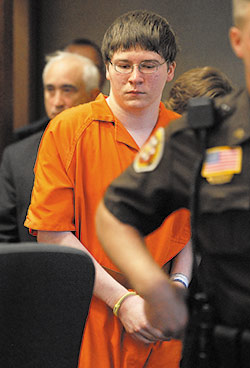Prosecutors, defense attorneys clash over interrogation techniques
By: Erika Strebel, [email protected]//February 18, 2016//
Prosecutors, defense attorneys clash over interrogation techniques
By: Erika Strebel, [email protected]//February 18, 2016//


If nothing else, the Netflix series “Making a Murderer” has put a spotlight on an unsettling practice that Julius Kim and other defense lawyers see all the time: The admission into evidence of statements gathered in coercive interrogations.
The 10-episode series centered on Steven Avery, a Manitowoc County man who spent nearly two decades in prison for a rape he was later found to have not committed. Avery was exonerated in 2003, only to be found guilty roughly two years later for the murder of Teresa Halbach, a freelance photographer.
Even though the series is mostly about Avery’s murder trial, perhaps the most unsettling moments come during footage showing law enforcement officers’ interrogation of his nephew, Brendan Dassey. Many viewers have come away from watching those segments with the belief that Dassey was manipulated into confessing that he played some part in Halbach’s death.
“Making a Murderer” might have marked the first time that many viewers have witnessed such techniques being put to use. But that does not mean coercion is uncommon, Kim said.
“That kind of stuff happens in the criminal justice system every day,” he said.
The law governing admissible statements is generally well settled. To be interrogated, suspects must be read their Miranda rights, waive those rights and then agree to subject themselves to law enforcement’s questioning.
The resulting statements, to be admitted, must also be voluntary. In deciding whether a statement was in fact provided willingly, courts are expected to gauge whether a defendant’s characteristics and mental state warranted the interrogation techniques police eventually used.
The law bars police interrogators from beating and threatening suspects, among other things. Any statement obtained through coercion is not supposed to be admitted as evidence.
Those rules, says St. Croix County District Attorney Eric Johnson, generally mean that prosecutors have an interest in making sure law enforcement officers don’t cross the line.
“Confessions and statements are key components in any criminal case,” Johnson said. “And if they’re thrown out, it’s a huge detriment for prosecutors. So prosecutors will work with law enforcement to make sure the statements are taken according to law.”
Also on the list of things not to do, law enforcement officers are supposed to not promise suspects things in return for statements, said Kim, an attorney at Kim & LaVoy in Brookfield. Most of these rules have had the desired effect of suppressing certain types of coercion, he said.
The trouble, Kim said, is that interrogation techniques are constantly changing.
“The days of beating people over the head are gone,” Kim said. “But that doesn’t mean that police don’t put pressure on suspects. Police tactics have evolved over time. The rubber hoses have been replaced by psychological tactics that are more effective.”
In theory, U.S. courts will not admit confessions obtained through the use of lies, trickery and deceit. In practice, though, misleading psychological techniques are used all the time to elicit statements that later find their way into court, Kim and others argue.
“Law enforcement officers have a good deal of flexibility to persuade an individual to answer questions and to challenge any answers that they think may be false or incomplete,” said Randy Kraft, communications director at the Wisconsin State Public Defender, which often represents defendants who lack the resources to hire a private attorney.
Among the questionable techniques law enforcement officers have been known to use, a particularly egregious one goes by the name of baiting. This happens when police imply or say they have incriminating information in order to get a particular response from a suspect.

Courts have been known to throw out confessions that were obviously elicited using baiting, said Ray Dall’Osto, a Milwaukee criminal defense attorney at Gimbel, Reilly, Guerin & Brown. Still, mischief continues to come from a large number of sources.
A big one, according to Dall’Osto and Kim, is the law’s assumption that defendants will not admit to something that they did not do. Recent advances in science suggest otherwise.
“You’re getting unreliable confessions. You’re getting people saying anything to get out of a very, very bad situation,” said Dall’Osto. “Do innocent people confess to things they haven’t done? Yes. The reality is that the system doesn’t want to admit it, but they can.”
Johnson countered that there are many techniques that fall well within the law and that law enforcement officers would be remiss to not use.
“In my position, that’s good police work,” he said. “That’s what they’re trained to do. There’s an art and science in getting statements from people. People don’t just right away start talking to you and start telling you the truth. So to get to the truth, there are certain techniques the officers have to use.”
Kim said he hopes that because videotaped interrogations are now so common, courts will become more familiar with interrogation techniques and will think twice before admitting evidence that was obtained in an improper way.
In Wisconsin, the state Supreme Court in 2005 adopted a rule requiring that law enforcement officers videotape all in-custody interrogations of juveniles. That rule was codified into legislation later the same year, along with another law requiring videotaped interrogations in adult felony cases.
The changes stemmed largely from recommendations made by a taskforce composed of prosecutors, defense attorneys and sociologists. Dall’Osto was among them.
He said videotaping has proved helpful, although there are still times when interrogation techniques do not end up on final recordings.
“I’ll tell you, the picture is worth a thousand words. It certainly is,” said Dall’Osto. “And the video? Even more. … That helps you assess what you’ve got: Was there a stop? Was there a reason for it? If there was a stop, was the appropriate questioning and field sobriety test done? Seeing that actual evidence out there, it’s critical.”
Legal News
- State Bar leaders remain deeply divided over special purpose trust
- Former Wisconsin college chancellor fired over porn career is fighting to keep his faculty post
- Pecker says he pledged to be Trump campaign’s ‘eyes and ears’ during 2016 race
- A conservative quest to limit diversity programs gains momentum in states
- Wisconsin prison inmate pleads not guilty to killing cellmate
- Waukesha man sentenced to 30 years for Sex Trafficking
- 12-year-old shot in Milwaukee Wednesday with ‘serious injuries’
- Milwaukee man convicted of laundering proceeds of business email compromise fraud schemes
- Giuliani, Meadows among 18 indicted in Arizona fake electors case
- Some State Bar diversity participants walk away from program
- Wisconsin court issues arrest warrant ‘in error’ for Minocqua Brewing owner
- Iranian nationals charged cyber campaign targeting U.S. Companies
WLJ People
- Power 30 Personal Injury Attorneys – Russell Nicolet
- Power 30 Personal Injury Attorneys – Benjamin Nicolet
- Power 30 Personal Injury Attorneys – Dustin T. Woehl
- Power 30 Personal Injury Attorneys – Katherine Metzger
- Power 30 Personal Injury Attorneys – Joseph Ryan
- Power 30 Personal Injury Attorneys – James M. Ryan
- Power 30 Personal Injury Attorneys – Dana Wachs
- Power 30 Personal Injury Attorneys – Mark L. Thomsen
- Power 30 Personal Injury Attorneys – Matthew Lein
- Power 30 Personal Injury Attorneys – Jeffrey A. Pitman
- Power 30 Personal Injury Attorneys – William Pemberton
- Power 30 Personal Injury Attorneys – Howard S. Sicula











